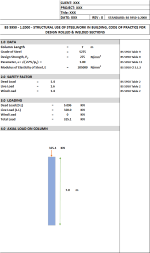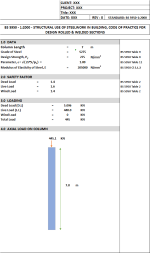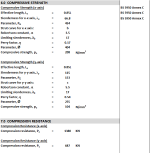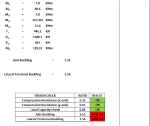column design BS 5950

Description
Calculation Reference
Structural Steel
Column Buckling
BS5950
Designing a structural column according to BS5950 involves a number of steps that include data collection, applying a safety factor, calculating loading and load effects, determining the type and class of the section, calculating compressive strength and resistance, assessing potential for lateral torsional buckling, performing local capacity checks, and checking for overall member buckling resistance.
Here is an outline of the steps involved:
1.0 Data: Gather all relevant data about the column, including its material (typically steel), dimensions (cross-sectional area, length, width, depth, etc.), location in the structure, and end conditions (pinned, fixed, etc.).
2.0 Safety Factor: Apply an appropriate safety factor to account for uncertainties in loading and resistance. In BS5950, this is referred to as the partial safety factor, and is typically taken as 1.0 for dead loads and 1.6 for imposed loads.
3.0 Loading: Determine the loads acting on the column, including dead loads (weight of the column itself and any other permanent loads), imposed loads (occupancy loads, furniture, equipment, etc.), wind loads, and any other applicable loads.
4.0 Axial Load on Column: Calculate the axial load on the column, which is the total of the applied loads multiplied by their respective safety factors.
5.0 Type of Section: Identify the type of steel section being used (e.g., universal column, rectangular hollow section, etc.).
5.1 Class of Section: Classify the section according to BS5950, which determines its buckling resistance. Class 1 and 2 sections can develop plastic resistance, while Class 3 sections can only develop elastic resistance.
6.0 Compressive Strength: Calculate the compressive strength of the column based on its material properties and geometry.
7.0 Compression Resistance: Determine the column's resistance to compressive forces, using the appropriate formulae from BS5950. This depends on the column's compressive strength and its slenderness ratio.
8.0 Lateral Torsional Buckling: Check for potential lateral torsional buckling, which can occur in slender sections subjected to bending. This involves checking the column's lateral torsional buckling resistance against the applied moment.
9.0 Local Capacity Check: Perform a local capacity check to ensure that the column can resist localized buckling under compression. This involves checking local buckling of individual plate elements in the section.
10.0 Member Buckling Resistance: Finally, check the column's overall buckling resistance, which depends on its length, end conditions, and slenderness ratio.
The Class of Section is a classification method provided in BS5950, which is used to categorize the buckling behavior of steel sections based on their geometry and the applied loads. These classifications influence the design of steel members as they provide insight into the load-bearing capacity of the sections before they buckle, affecting the strength calculations.
Here are the four classes:
-
Class 1 - Plastic Sections: These are sections where the stress in the steel can reach the plastic level (i.e., the material can yield and undergo large deformations without failing). This means that these sections can develop their full plastic moment capacity. They are typically thicker sections, and they are able to form a plastic hinge under severe loading before buckling occurs.
-
Class 2 - Compact Sections: For these sections, local buckling will occur after the attainment of yield stress but before the attainment of the plastic moment. However, they can still develop their full plastic moment capacity before local buckling occurs.
-
Class 3 - Semi-compact Sections: These sections will experience local buckling before the full plastic moment is developed, but after reaching the yield stress. The design of these sections is based on elastic stress distribution.
-
Class 4 - Slender Sections: For these sections, local buckling occurs before the yield stress is reached. The effective width of these sections must be calculated to determine their reduced load-bearing capacity.
The section class is used in determining the section capacity in terms of moment, compression, and shear. The section class is determined from the section properties (such as thickness, width, and overall dimensions) and the steel yield strength.
Calculation Preview
Full download access to any calculation is available to users with a paid or awarded subscription (XLC Pro).
Subscriptions are free to contributors to the site, alternatively they can be purchased.
Click here for information on subscriptions.










